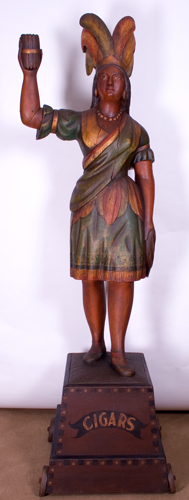Folk Art | Cigar Store Figures | Notes
 After the war at sea between the Monitor and the Merrimac, a revolutionary change occurs in ship building. Before that time the English and French wooded armed ships ruled the seas. The ship’s carvers, the men that carved the figures, rails, and all the necessary repairs, spent seven years as apprentices before becoming master carvers. This was a respectable middle class career in a time of extreme wealth and lower class.
After the war at sea between the Monitor and the Merrimac, a revolutionary change occurs in ship building. Before that time the English and French wooded armed ships ruled the seas. The ship’s carvers, the men that carved the figures, rails, and all the necessary repairs, spent seven years as apprentices before becoming master carvers. This was a respectable middle class career in a time of extreme wealth and lower class.
With the coming of metal ships and the death knell of the wooden ship industry, these enterprising carvers came to the United States with great ambition, talent and in need of employment.
There was little literacy in the United States in the first half of the 19th Century. Because of this, three dimensional figures depicting the main occupation of a store were hung or placed outside the establishment to attract customers. Trade “signs” such as barber poles, eyeglasses, scissors, tobacconist figures, etc., were carved by these master carvers.
By the early part of the 20th Century, the automobile began to replace the horse and buggy as the preferred mode of transportation. Accidents were becoming prevalent in cities as motorists noticed the shop signs and not the road. In big cities such as New York, Philadelphia and Baltimore ordinances were passed banning the outdoor trade signs from being along the streets. From about 1850 to 1920 it is estimated some 50,000 figures were produced. Most of these were relegated to the back of the store for destruction. They were the neon signs of their day and considered of no artistic value. (Note: a few astute collectors are rescuing discarded neon signs as I write.)
While there are no verifiable figures, I have been asking knowledgeable dealers and collectors for 35 years for their estimates of existing Tobacconist figures in museums and collections. We estimate there are 600-800 19th and early 20th Century figures.
The rarest figures are the non-Indian figures; such figures as the Punches, Turks, Jack Tars, etc. Unusual Indian figures such as a maiden with papoose, cross-legged maidens, scouts or “leaners” are also quite rare. In fact these people are rarer than the figures.
The highest prices go to the rarest figures with the best surfaces. Original paint in good condition will normally command the highest prices on rare figures. There are few figures with original paint since these figures were made to be outdoors and constant repair was necessary for their survival.
Most figures had some damage after the years due to children knocking them over or being hacked up with pen knives. Since they were not considered valuable, repairs were normally not done by professional restorers. Because of this, professionally restored figures command high prices.
Tobacconist figures were perhaps the first form of sculptural art produced in the United States, although the carvers didn’t consider themselves artists for the most part and the public did not consider it art until the 1940’s.
References:
Cigar Store Figures by A.W. Prendergast, 1953.
Artists in Wood: American Carvers of Cigar-Store Indians, Show Figures and Circus Wagons by Frederick Fried, 1970.
The Ship Carver’s Art: Figureheads and Cigar-Store Indians in Nineteenth-Century America by Ralph Sessions, 2005.
*The definitive Bible on the field is still Fred Fried’s book, in my opinion.
"Notes on Cigar Store Figures"
by George P. Viener
